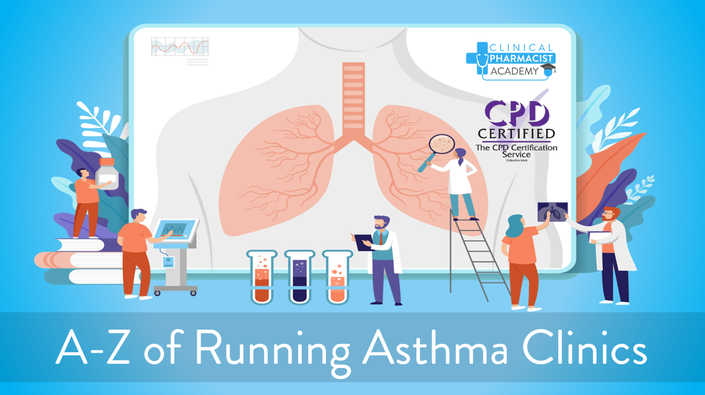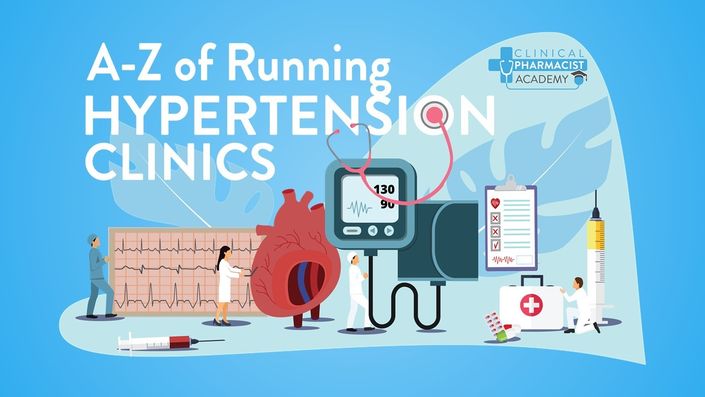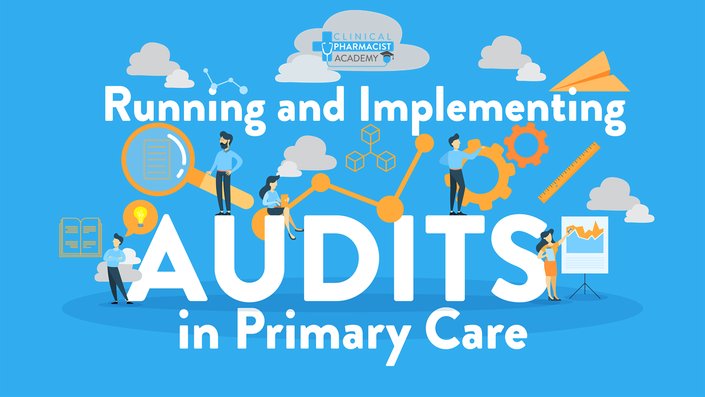
This is a comprehensive and practical programme that enables you to conduct Clinical Medication Reviews in General Practice.
- You will learn how to structure your clinical medication reviews
- Learn about all the monitoring requirements of 20 common chronic conditions
- Monitoring requirements of the medicines commonly used to treat those conditions
- Identify red flags and know when to refer
The content will take a deep dive into each condition which will cover:
- anatomy
- physiology
- pathophysiology
- monitoring requirements
- treatment
- ongoing management in primary care
The condition covered in the programme:
- Gout
- Diabetes
- Contraception
- Asthma
- COPD
- Anxiety
- Psychosis
- Depression
- Osteoporosis
- Dementia
- Rheumatoid Arthritis
- Dyspepsia
- Epilepsy
- Migraine
- Hypothyroidism
- Parkinsons
- Pain- Acute & Chronic
- Pain-Neuropathic
- Hormone Replacement Therapy
-
Heart Failure
Curriculum
- Introduction (1:41)
- Part 1: Definition and Anatomy (1:37)
- Part 1: Physiology (2:21)
- Part 1: Pathophysiology (2:11)
- Part 1: Management (5:16)
- Part 2: Information gathering and Initiating Medication Review (1:36)
- Part 2: Condition Monitoring (3:08)
- Part 2: Medication Monitoring (8:05)
- Part 2: Other Considerations and Advice (3:14)
- Part 2: Red Flags and Referrals (3:14)
- Part 2: Closing (1:29)
- Summary (1:37)
- Appendix 1
- Introduction (1:40)
- Part 1: Definition and Anatomy (1:01)
- Part 1: Physiology (3:59)
- Part 1: Pathophysiology (3:57)
- Part 1: Management (6:28)
- Part 2: Information Gathering and Initiating Medication Review (1:39)
- Part 2: Condition Monitoring (2:21)
- Part 2: Medication Monitoring (4:02)
- Part 2: Other Considerations and Advice (2:59)
- Part 2: Red Flags and Referrals (2:05)
- Part 2: Closing (0:50)
- Summary (1:55)
- Contraception
- Introduction (1:41)
- Part 1: Definition and Anatomy (2:16)
- Part 1: Physiology (5:19)
- Part 1: Management (8:09)
- Part 2: Information Gathering and Initiating Medication Review (1:32)
- Part 2: Contraception review (2:04)
- Part 2: Medication Monitoring (2:13)
- Part 2: Other Considerations and Advice (10:54)
- Part 2: Red Flags and Referrals (2:26)
- Part 2: Closing (1:18)
- Summary (1:22)
- ASTHMA
- Introduction (1:31)
- Part 1: Definition and Anatomy (2:41)
- Part 1: Physiology (4:57)
- Part 1: Pathophysiology (3:59)
- Part 1: Management (9:27)
- Part 2: Information Gathering and Initiating Medication Review (1:30)
- Part 2: Condition Monitoring (3:07)
- Part 2: Medication Monitoring (5:54)
- Part 2: Other Considerations and Advice (1:49)
- Part 2: Red Flags and Referrals (3:07)
- Part 2: Closing (1:13)
- Summary (1:26)
- COPD
- Introduction (1:42)
- Part 1: Definition and Anatomy (2:46)
- Part 1: Physiology (4:55)
- Part 1: Pathophysiology (5:53)
- Part 1: Management (14:05)
- Part 2: Information Gathering and Initiating Medication Review (1:34)
- Part 2: Condition Monitoring (2:35)
- Part 2: Medication Monitoring (5:25)
- Part 2: Other Considerations and Advice (2:33)
- Part 2: Red Flags and Referrals (2:44)
- Part 2: Closing (1:10)
- Summary (1:32)
- Anxiety
- Introduction (1:40)
- Part 1: Definition and Anatomy (1:12)
- Part 1: Physiology (5:17)
- Part 1: Pathophysiology (3:39)
- Part 1: Management (5:15)
- Part 2: Information Gathering and Initiating Medication Review (1:29)
- Part 2: Condition Monitoring (2:37)
- Part 2: Medication Monitoring (4:07)
- Part 2: Other Considerations and Advice (2:53)
- Part 2: Red Flags and Referrals (1:44)
- Part 2: Closing (0:45)
- Summary (1:48)
- Psychosis
- Introduction (1:50)
- Part 1: Definition and Anatomy (2:18)
- Part 1: Physiology (2:24)
- Part 1: Pathophysiology (4:58)
- Part 1: Management (7:36)
- Part 2: Information Gathering and Initiating Medication Review (1:32)
- Part 2: Condition Monitoring (3:11)
- Part 2: Medication Monitoring (3:14)
- Part 2: Other Considerations and Advice (2:57)
- Part 2: Red Flags and Referrals (3:21)
- Part 2: Closing (1:15)
- Summary (1:35)
- Depression
- Introduction (1:27)
- Part 1: Definition (0:53)
- Part 1: Anatomy (0:46)
- Part 1: Physiology (2:03)
- Part 1: Pathophysiology (2:42)
- Part 1: Management (7:06)
- Part 2: Information Gathering and Initiating Medication Review (1:42)
- Part 2: Condition Monitoring (3:28)
- Part 2: Medication Monitoring (11:45)
- Part 2: Other Considerations and Advice (3:22)
- Part 2: Red Flags and Referrals (1:31)
- Part 2: Closing (1:15)
- Summary (1:24)
- Osteoporosis
- Introduction (1:49)
- Part 1: Definition and Anatomy (2:07)
- Part 1: Physiology (4:45)
- Part 1: Pathophysiology (4:57)
- Part 1: Management (6:12)
- Part 2: Information Gathering and Initiating Medication Review (1:39)
- Part 2: Condition Monitoring (2:49)
- Part 2: Medication Monitoring (5:25)
- Part 2: Other Considerations and Advice (1:56)
- Part 2: Red Flags and Referrals (1:00)
- Part 2: Closing (1:19)
- Summary (1:36)
- Dementia
- Introduction (1:44)
- Part 1: Definition and Anatomy (1:34)
- Part 1: Physiology (3:34)
- Part 1: Pathophysiology (7:04)
- Part 1: Management (12:32)
- Part 2: Information Gathering and Initiating Medication Review (1:41)
- Part 2: Condition Monitoring (3:51)
- Part 2: Medication Monitoring (8:48)
- Part 2: Other Considerations and Advice (3:01)
- Part 2: Red Flags and Referrals (3:15)
- Part 2: Closing (1:16)
- Summary (1:32)
- Rheumatoid Arthritis - Introduction (1:26)
- Part 1: Definition and Anatomy (1:52)
- Part 1: Physiology (4:59)
- Part 1: Pathophysiology (6:13)
- Part 1: Management (5:51)
- Part 2: Information Gathering and Initiating Medication Review (1:39)
- Part 2: Condition Monitoring (3:08)
- Part 2: Medication Monitoring (9:45)
- Part 2: Other Considerations and Advice (1:46)
- Part 2: Red Flags and Referrals (3:47)
- Part 2: Closing (0:52)
- Summary (1:59)
- Dyspepsia
- Introduction (1:36)
- Part 1: Definition and Anatomy (1:22)
- Part 1: Physiology (5:39)
- Part 1: Pathophysiology (6:42)
- Part 1: Management (9:20)
- Part 2: Information Gathering and Initiating Medication Review (1:40)
- Part 2: Condition Monitoring (1:55)
- Part 2: Medication Monitoring (5:30)
- Part 2: Other Considerations and Advice (1:54)
- Part 2: Red Flags and Referrals (4:44)
- Part 2: Closing (1:21)
- Summary (1:35)
- Epilepsy
- Introduction (1:46)
- Part 1: Definition and Anatomy (1:19)
- Part 1: Physiology (3:12)
- Part 1: Pathophysiology (4:32)
- Part 1: Management (5:32)
- Part 2: Information Gathering and Initiating Medication Review (1:31)
- Part 2: Condition Monitoring (2:57)
- Part 2: Medication Monitoring (6:41)
- Part 2: Other Considerations and Advice (2:20)
- Part 2: Red Flags and Referrals (1:37)
- Part 2: Closing (0:54)
- Summary (1:55)
- Migraine
- Introduction (1:33)
- Part 1: Definition and Anatomy (3:40)
- Part 1: Physiology (8:28)
- Part 1: Pathophysiology (3:45)
- Part 1: Management (6:52)
- Part 2: Information Gathering and Initiating Medication Review (1:46)
- Part 2: Condition Monitoring (3:07)
- Part 2: Medication Monitoring (6:28)
- Part 2: Other Considerations and Advice (2:02)
- Part 2: Red Flags and Referrals (3:17)
- Part 2: Closing (0:57)
- Summary (1:56)
- Hypothyroidism
- Introduction (1:53)
- Part 1: Definition and Anatomy (2:05)
- Part 1: Physiology (1:23)
- Part 1: Pathophysiology (2:47)
- Part 1: Management (1:30)
- Part 2: Information Gathering and Initiating Medication Review (1:45)
- Part 2: Condition Monitoring (2:32)
- Part 2: Medication Monitoring (2:15)
- Part 2: Other Considerations and Advice (1:45)
- Part 2: Red Flags and Referrals (2:25)
- Part 2: Closing (1:16)
- Summary (1:41)
- Parkinsons
- Introduction (1:22)
- Part 1: Definition and Anatomy (1:55)
- Part 1: Physiology (9:26)
- Part 1: Pathophysiology (2:12)
- Part 1: Management (3:02)
- Part 2: Information Gathering and Initiating Medication Review (1:29)
- Part 2: Condition Monitoring (2:51)
- Part 2: Medication Monitoring (4:10)
- Part 2: Other Considerations and Advice (3:29)
- Part 2: Red Flags and Referrals (6:10)
- Part 2: Closing (1:21)
- Summary (1:34)
- PAIN - Acute and Chronic
- Introduction (1:34)
- Part 1: Definition and Anatomy (3:33)
- Part 1: Physiology (8:35)
- Part 1: Pathophysiology (5:57)
- Part 1: Management (4:05)
- Part 2: Information Gathering and Initiating Medication Review (1:33)
- Part 2: Condition Monitoring (3:44)
- Part 2: Medication Monitoring (7:14)
- Part 2: Other Considerations and Advice (2:30)
- Part 2: Red Flags and Referrals (5:07)
- Part 2: Closing (1:23)
- Summary (1:35)
- PAIN - Neuropathic
- Introduction (1:28)
- Part 1: Definition and Anatomy (3:18)
- Part 1: Physiology (8:31)
- Part 1: Pathophysiology (12:40)
- Part 1: Management (3:21)
- Part 2: Information Gathering and Initiating Medication Review (1:32)
- Part 2: Condition Monitoring (3:46)
- Part 2: Medication Monitoring (6:32)
- Part 2: Other Considerations and Advice (4:30)
- Part 2: Red Flags and Referrals (11:43)
- Part 2: Closing (1:14)
- Summary (1:33)
- Intro, Diagnosis & Classification. (2:58)
- QOF indicators (2:35)
- In Practice, Information Gathering (3:15)
- Actions to take (2:08)
- Monitoring weight (1:12)
- Drug treatment. (4:38)
- When to Refer. (2:13)
- Physical Assessment (3:16)
- Assessing Functional Status (1:09)
- Other Considerations (4:17)
- Templates (3:31)
Frequently Asked Questions
Q: How long will I have access to the online modules for?
Once you have purchased the online modules you will have access to them for 12 months.
Q: How long does a typical module take to complete?
On average we expect you to spend at least 1 hour per module.
Q: How many modules are there in total?
There are 20 modules in total.
Q: I would like my employer to fund this training for me, how do I go about this?
A: If your employer has already agreed to fund this training for you, please email us on: info@clinicalpharmacistsolutions.co.uk and we will invoice your employer.
If you would like some guidance on how to approach your employer to fund this training, please email us on info@clinicalpharmacistsolutions.co.uk and we will provide you with tailored advice depending on your practice needs.
If you still have questions, email us on info@clinicalpharmacistsolutions.co.uk
Supporting Pharmacists
Pharmacist Support is an independent, trusted charity, providing a wide variety of support services to pharmacists and their families, former pharmacists and pharmacy students.
Clinical Pharmacist Academy is a Pharmacist run organisation and understands the difficulties our colleagues can face. We are proud to support Pharmacist Support and pledge £5 from each training programme enrolment through our Clinical Pharmacist Academy platform.
Our aim is to support Pharmacists to transition and accelerate their development within the Primary Care sector. We want to see all Pharmacists utilise their unique skillset and fulfil the great potential that they have in Primary Care.
If you are a Pharmacist, we would encourage you to check their website for all the support available to you.





